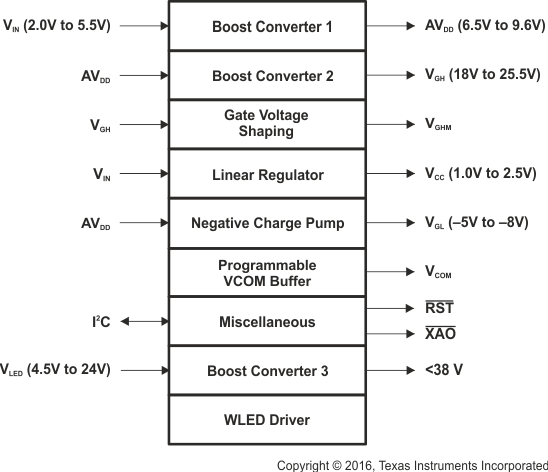-
TPS65154 LCD Bias IC with Integrated WLED Driver
- 1 Device Overview
- 2 Revision History
- 3 Pin Configuration and Functions
- 4 Specifications
-
5 Detailed Description
- 5.1 Overview
- 5.2 Functional Block Diagram
- 5.3 Feature Description
- 5.4 Device Functional Modes
- 5.5
Programming
- 5.5.1 Configuration
- 5.5.2
Programming Examples (Excluding VCOM)
- 5.5.2.1 Writing to a Single RAM Register
- 5.5.2.2 Writing to Multiple RAM Registers
- 5.5.2.3 Saving Contents of all RAM Registers to EEPROM
- 5.5.2.4 Reading from a Single RAM Register
- 5.5.2.5 Reading from a Single EEPROM Register
- 5.5.2.6 Reading from Multiple RAM Registers
- 5.5.2.7 Reading from Multiple EEPROM Registers
- 5.5.3 Programming Examples - VCOM
- 5.6
Register Map
- 5.6.1
Configuration Registers (Excluding VCOM)
- 5.6.1.1 CONFIG (00h)
- 5.6.1.2 VCC (01h)
- 5.6.1.3 DLY1 (02h)
- 5.6.1.4 AVDD (03h)
- 5.6.1.5 FSW1 (04h)
- 5.6.1.6 SS2 (05h)
- 5.6.1.7 DLY2 (06h)
- 5.6.1.8 VGL (07h)
- 5.6.1.9 SS3 (08h)
- 5.6.1.10 DLY3 (09h)
- 5.6.1.11 VGH (0Ah)
- 5.6.1.12 SS4 (0Bh)
- 5.6.1.13 FSW3 (0Ch)
- 5.6.1.14 DLY4 (0Dh)
- 5.6.1.15 OVP (0Eh)
- 5.6.1.16 FDIM (OFh)
- 5.6.1.17 RESET (10h)
- 5.6.1.18 VDET (11h)
- 5.6.1.19 DLY6 (12h)
- 5.6.1.20 VMAX (13h)
- 5.6.1.21 VMIN (14h)
- 5.6.1.22 USER (15h)
- 5.6.1.23 CONTROL (FFh)
- 5.6.2 VCOM Registers
- 5.6.1
Configuration Registers (Excluding VCOM)
- 6 Application and Implementation
- 7 Power Supply Recommendations
- 8 Layout
- 9 Device and Documentation Support
- 10Mechanical, Packaging, and Orderable Information
- IMPORTANT NOTICE
Package Options
Mechanical Data (Package|Pins)
- RSL|48
Thermal pad, mechanical data (Package|Pins)
- RSL|48
Orderable Information
DATA SHEET
TPS65154 LCD Bias IC with Integrated WLED Driver
1 Device Overview
1.1 Features
- 2.0 V to 5.5 V Input Voltage Range
- Synchronous Boost Converter (AVDD)
- Non-Synchronous Boost Converter (VGH)
- Low Dropout Linear Regulator (VCC)
- Programmable VCOM Calibrator with Integrated Buffer Amplifier
- 6-Channel WLED Driver with Direct Dimming and Phase-Shift Dimming Modes
- Gate Voltage Shaping
- Panel Reset Signal (XAO)
- T-CON Reset Signal (RST)
- On-Chip EEPROM with Write Protect
- I2C Interface
- Thermal Shutdown
- 48-Pin, 6 mm × 6 mm, 0.4 mm Pitch VQFN
1.2 Applications
- Notebook PCs
- Tablet PCs
1.3 Description
The TPS65154 is a compact LCD bias solution primarily intended for use in Notebook and Tablet PCs. The device comprises two boost converters to supply the LCD panel's source driver and gate driver; a linear regulator to supply the system's logic voltage; a programmable VCOM with high-speed amplifier; and a gate voltage shaping function; and a 6-channel WLED driver.
spacing
Device Information(1)
| PART NUMBER | PACKAGE | BODY SIZE (NOM) |
|---|---|---|
| TPS65154 | VQFN (48) | 6.00 mm × 6.00 mm |
(1) For all available packages, see the orderable addendum at the end of the data manual.
1.4 Simplified System Diagram
